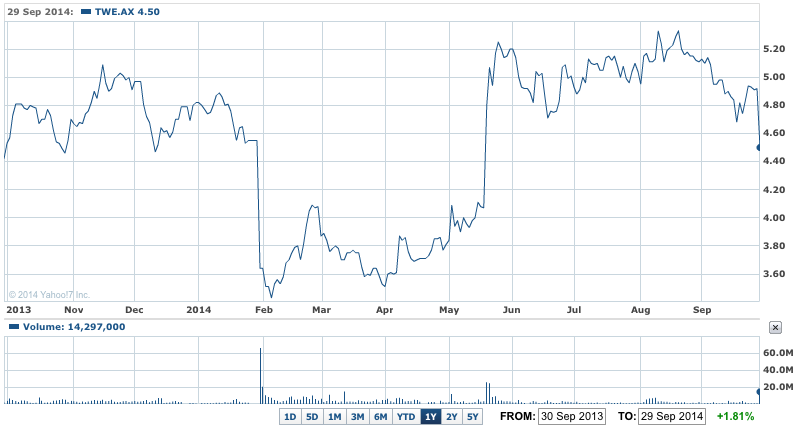Naturally shares in Treasury Wine Estates (TWE) fell heavily yesterday after it ended talks with two private equity groups on a possible buyout at $5.20 a share.
The shares fell to a day’s low of $4.13 before bouncing to end at $4.50, a fall of 8%, a lot less than the earlier losses.
Once the offer price is rejected, the shares in the target company fall heavily as hedge funds and other speculators abandon the stock and try and save their profits.
It can be an ungainly exit and the shares can fall heavily – and then remain at low levels while everyone reassesses their positions.
The board and management of the target company can come under pressure from noisy shareholders wanting the profits now and not in the future, or growth.
The TWE board and management have that ahead of them at the AGM whenever that is called. The timing was left uncertain yesterday by the company.
And when the target is an indifferent performer like Treasury Wine Estates with a track record of weak investments and management and a slack board, the feeling about lost profits can be intense.
TWE 1Y – Treasury Wine terminates talks with bidders

But from what Treasury Wine Estates said yesterday, it terminated the talks with private equity firms Kohlberg Kravis Roberts and TPG Capital because they wouldn’t sweeten the $5.20 suggested offer price.
And the board did that with the support of the majority of big shareholders who agreed the potential $3.4 billion buyout undervalued the company.
Treasury chairman Paul Rayner said yesterday the company had consulted a wide range of institutional shareholders making up about half of the Treasury share register and they were universal in their views that $5.20 wasn’t enough to justify a change of control.
Mr Rayner said the board had decided that the company’s own fix-it plans under chief executive Michael Clarke were a better bet.
“These discussions provided a forum for these shareholders to express a view on the proposals, with clear feedback from almost every one of these shareholders indicating that they believed a price of $5.20 per share undervalued the company," Mr Rayner said in a statement to the ASX.
Media reports suggested that KKR and junior partner Rhone Capital offered just under $5.20 per share in a final bid made late on Friday. The reports said that TPG’s final offer late on Friday was pitched at between $4.50 a share and $4.70 per share (which was the starting price for KKR’s original offer).
"The Company made clear in communications to the market at the time that there was no certainty a formal offer would eventuate but that it was in the best interests of shareholders to engage with the bidders. On that basis, each was given an opportunity to conduct non-exclusive due diligence," TWE said in yesterday’s statement.
"Throughout the due diligence process the private equity bidders indicated support for Management’s strategic plans and roadmap. They also did not identify any major concerns with the business. However, it is now apparent to the Company that the bidders are not able to support a transaction on terms and at a price acceptable to the Board.
"Year-to-date performance is tracking ahead of plan and TWE will provide shareholders with an update on the Company’s strategic roadmap and performance at its Annual General Meeting (date to be advised).
"Over the past month the Board and Management held discussions with shareholders holding in aggregate approximately 50% of the Company’s shares. These discussions provided a forum for these shareholders to express a view on the proposals, with clear feedback from almost every one of these shareholders indicating that they believed a price of $5.20 per share undervalued the Company," the company said.
In yesterday’s statement the company said it believes its existing strategy is supported by major shareholders, the Board and Management. These plans include:
• Increase and accelerate consumer marketing investment in the Company’s brands;
• Change Penfolds release dates;
• Deliver the significant overhead cost reduction program;
• Deliver supply chain savings and efficiencies through a separate focus on the Commercial portfolio versus the Luxury & Masstige portfolio in Australia; and
• Build improved momentum in the top line through stronger consumer, retailer and distributor relationships, enhanced marketing programs and a greater focus on the Company’s priority brands.













